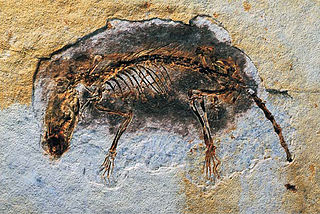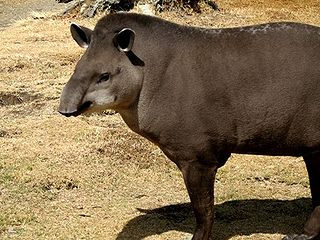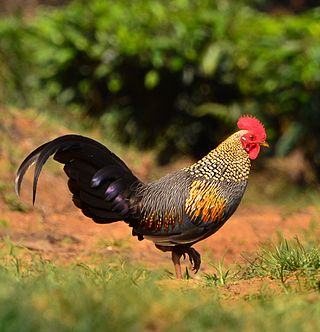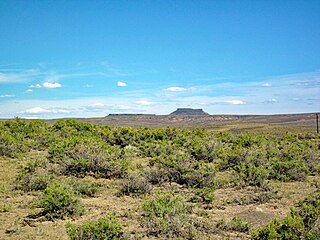
Eomaia is a genus of extinct fossil mammals containing the single species Eomaia scansoria, discovered in rocks that were found in the Yixian Formation, Liaoning Province, China, and dated to the Barremian Age of the Lower Cretaceous about 125 million years ago. The single fossil specimen of this species is 10 centimetres (3.9 in) in length and virtually complete. An estimate of the body weight is 20–25 grams (0.71–0.88 oz). It is exceptionally well-preserved for a 125-million-year-old specimen. Although the fossil's skull is squashed flat, its teeth, tiny foot bones, cartilages and even its fur are visible.

Gekkonidae is the largest family of geckos, containing over 950 described species in 64 genera. The Gekkonidae contain many of the most widespread gecko species, including house geckos (Hemidactylus), the tokay gecko (Gekko), day geckos (Phelsuma), the mourning gecko (Lepidodactylus), and dtellas (Gehyra). Gekkonid geckos occur globally and are particularly diverse in tropical areas.

Tylopoda is a suborder of terrestrial herbivorous even-toed ungulates belonging to the order Artiodactyla. They are found in the wild in their native ranges of South America and Asia, while Australian feral camels are introduced. The group has a long fossil history in North America and Eurasia. Tylopoda appeared during the Eocene around 50 million years ago.

A true toad is any member of the family Bufonidae, in the order Anura. This is the only family of anurans in which all members are known as toads, although some may be called frogs. The bufonids now comprise more than 35 genera, Bufo being the best known.

Mesonyx is a genus of extinct mesonychid mesonychian mammal: fossils of the various species are found in Early to Late Eocene-age strata in the United States and Early Eocene-aged strata in China, 51.8—51.7 Ma (AEO).

Megalictis is an extinct genus of large predatory mustelids that existed in North America during the "cat gap" from the Late Arikareean (Ar4) in the Miocene epoch. It is thought to have resembled a huge, jaguar-sized ferret, weighing up to 60–100 kilograms (130–220 lb).

Tapiroidea is a superfamily of perissodactyls which includes the modern tapirs and their extinct relatives. Taxonomically, they are placed in suborder Ceratomorpha along with the rhino superfamily, Rhinocerotoidea.The first members of Tapiroidea appeared during the Early Eocene, 55 million years ago, and were present in North America and Asia during the Eocene. Tapiridae first appeared during the early Oligocene in Europe, and are thought to have originated from the tapiroid family Helaletidae.

The Sićevo Gorge, a river gorge and archaeological site in southeastern Serbia, is the locally most prominent geological and topographic feature formed by the Nišava River. The gorge is located between the towns of Bela Palanka and Niška Banja. It is 17 km (11 mi) long and 350 to 400 m deep, in some parts developing canyon-like structures. The gorge is cut into the Kunovica plateau, between the southern slopes of the Svrljig Mountains and the mountain of Suva Planina. The surrounding areas are known for their high-quality vineyards. The gorge contains a stone quarry, the Ostrovica and six villages. The largest, Sićevo is the eponym of the gorge.

Paralligator is an extinct genus of neosuchian crocodylomorph that lived during the Late Cretaceous (Cenomanian-Maastrichtian) period in what is now the Bayan Shireh and Nemegt formations of Mongolia, approximately 96 million to 70 million years ago. P. gradilifrons reached up to 4 m (13 ft) in length.

Pangalliformes is the scientific name of a provisional clade of birds within the group Galloanserae. It is defined as all birds more closely related to chickens than to ducks, and includes all modern chickens, turkeys, pheasants, and megapodes, as well as extinct species that do not fall within the crown group Galliformes.

Tamanu oil is pressed from nuts of either Calophyllum inophyllum (usually) or Calophyllum tacamahaca (ati), tropical trees belonging to the Calophyllaceae family. The oil originates in Polynesia, where it continues to play an important cultural role.

Homotherini is a tribe of saber-toothed cats of the family Felidae. The tribe is commonly known as scimitar-toothed cats. These saber-toothed cats were distributed en North America, Europe, Asia, Africa, and South America from the Miocene to Pleistocene living from c. 23 Ma until c. 12,000 years ago.

Kate Robb is an Australian marine mammalogist who, along with colleagues, declared in 2011 a new species of the genus Tursiops, and formally named it the Burrunan dolphin, Tursiops australis. She is the Founding Director and Head of Research at the Marine Mammal Foundation in Melbourne in the Australian state of Victoria.

Qarmoutus hitanensis is an extinct ariid catfish whose fossils were first discovered in Birket Qarun Formation, Wadi Al-Hitan, Egypt. It lived during the Eocene period around 37 million years ago, and its body length is estimated to be about 6.5 feet long.

Anatoliadelphys maasae is an extinct genus of predatory metatherian mammal from the Eocene of Anatolia. It was an arboreal, cat-sized animal, with powerful crushing jaws similar to those of the modern Tasmanian devil. Although most mammalian predators of the northern hemisphere in this time period were placentals, Europe was an archipelago, and the island landmass now forming Turkey might have been devoid of competing mammalian predators, though this may not matter since other carnivorous metatherians are also known from the Cenozoic in the Northern Hemisphere. Nonetheless, it stands as a reminder that mammalian faunas in the Paleogene of the Northern Hemisphere were more complex than previously thought, and metatherians did not immediately lose their hold as major predators after their success in the Cretaceous.
Hilalia is an extinct genus of condylarth that lived during the Eocene. Fossils of Hilalia have been found at Uzunçarsidere Formation in Turkey. It was the last surviving genus of Pleuraspidotheriids, which were previously thought to have gone extinct during the Late Palaeocene.
For some 10 million years until the end of the Eocene, Balkanatolia was an island continent or a series of islands, separate from Asia and also from Western Europe. The area now comprises approximately the modern Balkans and Anatolia. Fossil mammals from this area are distinct from the mammal fauna of either western Europe or Asia.

Hyainailourinae ("hyena-cats") is an extinct subfamily of hyainailourid hyaenodonts that lived in Africa, Asia, North America and Europe from the middle Eocene to middle Miocene. They appeared in Africa about 47.8 Ma ago and soon after spread as far as East Asia.

Krommaster is a genus of early ophiuroids that lived nearlt 410 million years ago in the early Devonian period, South Africa, Baviaanskloof formation, upper unit, Cape super group, Table Mountain group, Eastern cape. This genus has one species which is Krommaster spinous. This species was discovered along side with Hexuraster weitzi, another species of brittle star living in the same area.

















